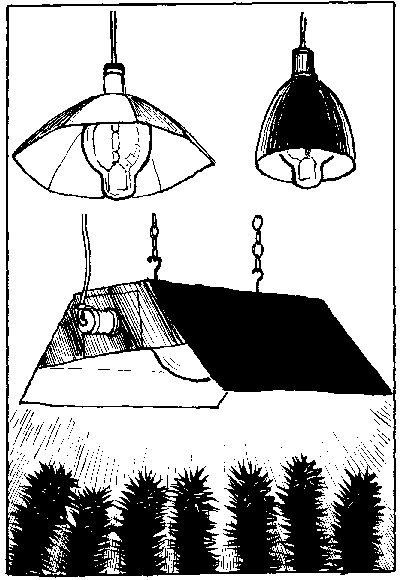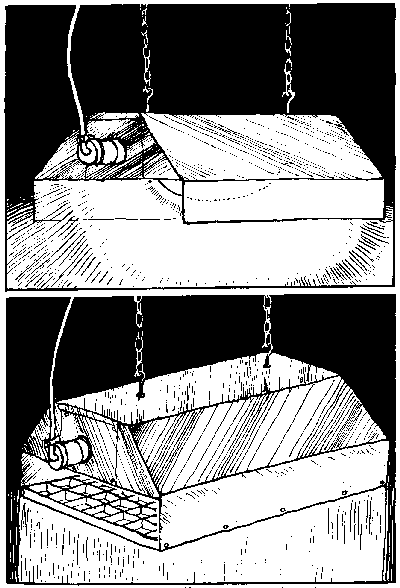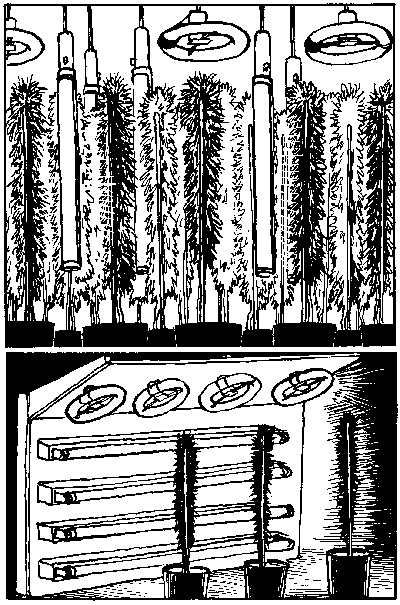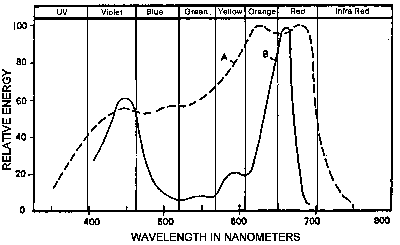LIGHTS AND REFLECTORS
Sunlight comes from a distant source, so that the light rays hitting a small portion of planet Earth (say a garden 12 feet wide) are virtually parallel. Their intensity does not diminish over the length of a plant 6 feet tall.
Light emitted from tubes and lamps travels in all directions. As the distance from the lamp increases, the intensity of the light decreases. It is not that any light is lost, just that the same amount of light is spread over larger area.
HID lamps and reflectors come in two configurations. Either the lamps are held vertically or horizontally.
Horizontally held lamps direct most of the light downward because the light is emitted along the length of the lamp. Only a small reflector is required to beam the rest of the light downward.
Vertical lights emit most of their light horizontally. In order to reach a garden, the light must be reflected downward using a large, bulky reflector. Manufacturers have developed elaborate and innovative hoods, still they cannot reach the light delivery efficiency of a horizontal lamp.
Horizontally held lamps have several other advantages over verticals. They take less vertical space, which is crucial for short gardens, and the reflectors are much less bulky. All in all, horizontally held lamps are considered the best configuration for the closet garden.
Aluminum reflectors deliver the most light, more than white ones. Stainless steel reflectors absorb some spectrums of light and should not be used.

FLUORESCENT LIGHT REFLECTORS
A garden lit by two tubes per foot of width with a high quality reflector receives about 1,100 lumens per square foot. A garden lit by three tubes per foot of width receives about 1700 lumens per square foot.
Fluorescents come in many lengths, but the two most commonly used by indoor gardeners are 4 and 8 ft lengths. They are convenient to use and are more efficient than other sizes.
Poorly designed fluorescent fixtures, with no baffles between the tubes to reflect light downward may lose up to 40% of the light. Instead, tubes are mounted onto a reflector with individual baffles between the tubes so that light is directed downward to the garden. A good reflector may keep losses down to 20%. An alternative is to use tubes with reflective surfaces. These are made several manufacturers. Often stores do not carry them but will special order them.


Light Spectrums and Photosynthesis
Each source of light has a characteristic spectrum, which is caused by the varying wave lengths of light therein. Fluorescents and other electric lights emit different shades of light. To our eyes midday summer sunlight looks neutral, incandescent lights have a reddish tint, fluorescents vary in spectrum according to their type, MH lamps a have a blue coolness to them, and HPS lamps look pink-amber.
To produce chlorophyll, plants need light from specific spectrums, (TABLE 1) mainly red and blue. This is called the chloroplast light spectrum. Once the chlorophyll is produced, a slightly different spectrum of light (TABLE 1) is used by the plant for photosynthesis, the process which results in the production of sugars. Plants use red and blue light most efficiently but they also use orange and yellow light. Plants are continually growing, producing new chloroplasts and chlorophyll so both spectrums of light are being used by the plant continually. Plants reflect green light rather than using it.
(B) Chlorophyll Synthesis

Although the MH and HPS lamps emit different color light both lamps emit high levels of light in the critical red and blue wavelengths. Either lamp can be used for cultivation. HPS lamps produce faster growth because they emit more total light useable by the plant.
Many shop owners maintain that combinations of MH and HPS lights produce the fastest growth, or alternatively, that MH units should be used for growth and HPS units for flowering. There is no indication that either of these theories holds up. HPS lamps produce faster growth than a combination of HPS and MH lamps. There is absolutely no need to or advantage to buying a MH unit. Plants grown under HPS show some stem etoliation (stretching) and ripen about a week later. This is more than compensated with a considerably larger crop.
Some fluorescent tube manufacturers produce grow tubes which are especially formulated to provide a spectrum of light similar to the chlorophyll synthesis or photosynthesis spectrum or a compromise between them. The idea is sound, but grow tubes produce only 35-60% of the light of a cool white fluorescent, and less light useable by the plant. One manufacturer advertises Vita-Lite® and Optima® fluorescent tubes which emit a light spectrum color balanced close to the suns spectrum. However, they emit only 75% of the light of a warm white fluorescent.
COSTS
HPS systems are the most expensive to purchase of all of the lighting units. MH units are a little cheaper and fluorescents are the cheapest of all. However, this is figuring only the initial outlay. Factoring in the cost per unit of light produced, the positions are reversed. HPS lamps are the cheapest, followed by MH lamps and far behind come the fluorescents. In addition HID lamps are considered easier to work with in the garden and produce a better crop than fluorescents.
Cost in cents per 1000 lumens of various lamps.
(Expressed in cents per kilowatt)